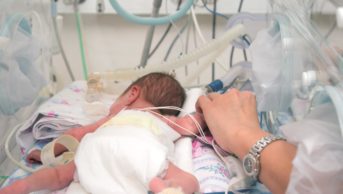
ChameleonsEye / Shutterstock.com
In this article you will learn:
- How to recognise the signs and symptoms of postnatal depression
- How to continue therapy for patients with postnatal depression wishing to breastfeed
- How to select the most appropriate antidepressant for patients with postnatal depression wishing to breastfeed
Postnatal depression occurs after a woman has given birth and can occur any time up until one year after delivery[1]
,[2]
. Postnatal depression is a relatively common condition that occurs in around 10–15% of women following childbirth. Many cases also occur in the prenatal or perinatal period[1]
,[2]
.
The World Health Organization (WHO) recommends children are breastfed exclusively for at least the fi
rst four to six
months of life[3]
. Ho
wever, this can be complicated if the mother requires treatment for depression, and there is a lack of robust evidence to guide choice of treatment. This article looks at the main aspects of treating postnatal depression, focusing on the use of antidepressant medications in breastfeeding.
Postnatal depression: risks, signs and symptoms
The overall risk and prevalence of postnatal depression does not appear to be significantly different than for depression in general, although there seems to be an increased risk of developing depression in the early postnatal period. The risk may be increased by as much as threefold in the first five weeks after the birth, potentially caused by the stressful experience of childbirth and adjustment to the new baby[4]
.
The major risk factors for developing postnatal depression include previous history of depression, poor social support, poor relationship with a partner and recent life events[1],[5]
.
Signs and symptoms are the same as for non-postnatal depression and include a persistent low mood, lack of interest and enjoyment in usual activities and a lack of energy, although it is important to differentiate between depressive symptoms and normal emotional changes that occur at this time. In addition, postnatal depression can also have negative consequences on the developing relationship between the mother and child, as well a
s with the partner and family[2]
. If left untreated, postnatal depression can have effects on the child’s cognitive and emotio
nal development in both
the short term and long term[6]
. Suicide remains one of the leading cause of maternal death in the p
ostnatal period
, a
ccounting for 29 out of 261 maternal deaths reported in th
e UK between 2006 and 2008[7]
.
Women should be routinely assessed for signs of postnatal depression at appointments with their healthcare providers and should be referred to their GP or mental health team if there are any concerns[2]
. Women may be reluctant to seek help for depression during the postnatal period as they may fear that they will get a negative response and that it may lead to people thinking they are unfit to care for their child. However, women should be reassured that seeking help will be seen as a positive step and appropriate treatment will help improve their ability to look after themselves and their baby.
There is little evidence to guide treatment selection in postnatal depression. Therefore, guidelines for managing depression are followed, taking into account the safety of the medication for both the mother and, where relevant, the child. Women who choose not to breastfeed can be treated with any suitable antidepressant indicated.
Management in breastfeeding
The threshold for medical treatment is generally higher in women who are pregnant or breastfeeding compared with the general population, and non-medical interventions should be considered first[5]
.
Timely access to psychotherapy should be available to all women diagnosed with postnatal depression and should be the mainstay of treatment for those with mild to moderate depression[1]
,[2]
. Psychotherapy can be considered as a treatment option for those with severe depression, particularly if the woman does not want to take medicines. Although limited, there is evidence for a range of psychosocial and psychological interventions in postnatal depression, in particular cognitive behavioural therapy (CBT) and interpersonal psychotherapy (IPT)[1]
,[2],[8]
.
Medicines can be considered if depression is severe; if the mother has a history of severe depression requiring treatment with antidepressants; if psychotherapy is ineffective; or if the woman chooses pharmacotherapy over psychotherapy[1]
,[2]
. Treatment should not be withheld to allow breastfeeding to occur.
The majority of information available on the effects of antidepressants in breastfeeding is only applicable to healthy babies born to term. Premature babies, or those with any other illnesses such as cardiac disease or hepatic impairment, may be more susceptible to adverse effects of medicines taken by the mother (on account of a limited capacity to remove medication, which can put them at risk), and therefore specialist advice should always be sought before the mother starts to breastfeed.
With a lack of robust evidence for treating postnatal depression, the choice of antidepressant is mainly guided by any previous effective treatment and its compatibility with breastfeeding (see ‘Antidepressants and breastfeeding’)[9]
.
| Antidepressants and breastfeeding | ||
|---|---|---|
| Source: The Maudsley Prescribing Guidelines in Psychiatry [10] , Drugs During Pregnancy and Lactation – Treatment Options and Risk Assessment [11] , Psychotropic Drug Directory [12] , UK Drugs in Lactation Advisory Service [13] | ||
| Drug | Compatibility with breastfeeding | |
| First line Low levels of infant exposure anticipated, evidence of safe use or drug properties compatible with breastfeeding | Sertraline | Low levels of exposure via milk expected. Often recommended as the antidepressant of choice in breastfeeding. |
| Paroxetine | Short half-life limits potential for accumulation but increases risk of withdrawal effects. Avoid if there is a risk of subsequent pregnancy. | |
| Imipramine, nortriptyline | Short half-lives and lower risk of sedation or antimuscarinic adverse effects compared with other tricyclic antidepressants. | |
| Second line Limited evidence of safety or exposure to drug via milk anticipated. May be considered if previous good response and can be continued if treatment is already established | Fluoxetine, citalopram, escitalopram | Risk of accumulation caused by secretion in milk and long half life. |
| Mirtazapine | May cause sedation, particularly at 15mg dose, but infant exposure is thought to be low. | |
| Venlafaxine | Higher risk of discontinuation reactions, serum infant levels may be higher than seen with other options. | |
| Duloxetine | Longer half-life may lead to accumulation in infant but in limited studies milk levels appear to be low. | |
| Tricyclic antidepressants (e.g. amitriptyline, clomipramine, doxepin) | Higher risk in overdose and often less well tolerated. Some tricyclic antidepressants are highly sedative, which could cause sedation in mother and infant. Some resources recommend avoiding doxepin because of concerns over reported infant adverse effects. | |
| Less preferred options in breastfeeding because of lack of evidence, safety concerns or generally less preferred in depression | Reboxetine | Very limited experience, not commonly used in depression. |
| Agomelatine | Very limited experience, associated with hepatotoxicity in adults and requires hepatic monitoring in adults. | |
| Monoamine oxidase inhibitors | Risk of food interactions in mother and baby, rarely used in practice. Expert advice should be sought. | |
Continuing antidepressants
Some women will already be treated with antidepressants when they become pregnant, or may be started on antidepressants during pregnancy. Overall, there is a lack of safety data (particularly long-term safety) on the use of antidepressants in pregnancy[9]
. Interpreting the information is also difficult, as much of this comes from observational studies that may be complicated by factors such as concurrent medicines and lifestyle (e.g. diet, smoking, illicit substances).
W
omen already taking antidepressants should be encouraged to continue treatment postnatally and for at least six months after resolution of the depression depending on the number of previous episodes of depression, as the risk of relapse is linked to stopping treatment. Even treatments not considered first-line options in breastfeeding (e.g. citalopram or fluoxetine) can be continued with careful monitoring of the mo
ther and baby
[6]
. Switching
from an effective medication to a previously untried medication in the postnatal period is discouraged, as this increases risk of relapse.
Stopping antidepressants abruptly may lead to withdrawal effects in both the mother and child, such as gastrointestinal disturbances, dizziness, headache, insomnia, anxiety and flu-like symptoms in the mother, or irritability, sleep disturbances or persistent crying in the chil
d[14]
. Withdrawal eff
ects are usually mild and self-limiting but can be more severe and distressing for some and require reintroduction of the previ
ous medication
[14]
. Continuing antidepressants while breastfeeding may attenua
te potential withdrawal effects of the antidepressan
t in the neonate[10]
.
If antidepressants are started during pregnancy, the mother’s intention to breastfeed should be discussed to help select the most appropriate treatment.
Choice of antidepressant
Women starting antidepressants for postnatal depression are usually prescribed a selective ser
otonin re
uptake inhibitor (SSRI)[15]
. Hi
ghly sedative antidepressants, such as trazodone, amitriptyline and dosulepin, should be avoided because they impact on the mother’s ability to carry out their normal routine and may cause sedation in the infant. If highly sedative antidepressants are used, mothers should be strongly advised not to sleep in the same bed as the in
fant[1]
.
The SSRI
of choice for depre
ssion in women who are breastfeeding is sertraline because of its relatively shorter half-life compared with fluoxetine or citalopram, which have the potential to accumulate in the child. All antidepressants can secrete into breast milk but to differing amo
unts[16]
. Paroxetine is consi
dered a safe option in breastfeeding, although it is more commonly associated with withdrawal reactions, including gastrointestinal disturbances, dizziness, headache, insomnia, anxiety and flu-like symptoms, and antimuscarinic side effects
[10]
, including dry mouth, blurred vision, constipation and sedation compared with the other SSRIs and therefore tends to be used less frequently. Paroxetine may also not be preferred if the ri
sk of a subsequent pregnancy is high[11]
.
Tricyclic antidepressants (TCAs)
are not used as fr
equently as SSRIs in women who are breastfeeding because of the risk of overdose and the risk of adverse effects, which include cardiac adverse effects, such as hypotension, arrhythmias and ECG changes, antimuscarinic side effects, and central nervous system effects, such as dizzin
ess, sedation and confuision
[14]
. Where a TCA is
indicated, imipramine or nortriptyline are usually preferred in breastfeeding because of their shorter half-lives and lower risk of sedatio
n compared with other TCAs[17]
.
Other antidepressants
, suc
h as
venlafaxine, duloxetine, mirtazapine and trazodone, are not normally considered as first-line treatments in breastfeeding women, as safety data is limited. However, they may be considered in situations where a mother has previously used the medicine and wishes to continu
e treatment[18]
. Monoamine oxidase inhibitors are not recommended because of a lack of evid
ence of their use in breastfe eding and the theoretical potential for them to have food or drug interactions in the ne
onate[18]
.
W
omen should be advised not to use complementary therapies, such as St John’s Wort, Gingko biloba or Valer ian, as they are not recommended for use in depression and there is a lack of safety information on their u
se in breastfeeding
[15],
[19]
.
W
hen medication is used, it is preferable to use a single medication at the lowest effective dose to reduce the exposure of the baby to the antidep
ressant, although care should be taken to ensure that the dose is not so low as to deem it ineffective[2]
. Both the mother
and the baby should be closely monitored for effectiveness and adverse effects. There is no specific guidance for length of treatment in postnatal depression and treatment is usually continued for at least six mo
nths after recovery[12]
,
[20]
. If treatment is not effective, the woman sh
ould be referred to a psychiatric sp
ecialist.
Attemp
ting to reduce exposure of the child to the antidepressant by avoiding feeding when peak drug levels occur is not practical, and is not recommen
ded in practice
[20]
.
Nicola Carson is medical information manager, Central and North West London NHS Foundation Trust.
How to have effective consultations on contraception in pharmacy
What benefits do long-acting reversible contraceptives offer compared with other available methods?
Community pharmacists can use this summary of the available devices to address misconceptions & provide effective counselling.
Content supported by Bayer
References
[1] Scottish Intercollegiate Guidelines Network (SIGN). Management of perinatal mood disorders: SIGN publication number 127. 2012. Available at: www.sign.ac.uk/pdf/sign127.pdf (accessed August 2015).
[2] National Institute for Health and Care Excellence (NICE). Clinical Guideline CG192: Antenatal and Postnatal Mental Health. 2014. Available at: www.nice.org.uk/guidance/cg192/resources/guidance-antenatal-and-postnatal-mental-health-clinical-management-and-service-guidance-pdf (accessed August 2015).
[3] World Health Organisation (WHO). Health Topic: Breastfeeding. 2015. Available at www.who.int/topics/breastfeeding/en/ (accessed August 2015).
[4] Gaynes BN, Gavin N, Meltzer-Brody S et al. Perinatal depression: prevalence, screening accuracy, and screening outcomes. Evid Rep Technol Assess (Summ) 2005;119:1–8.
[5] Musters C, McDonald E & Jones I. Management of postnatal depression. BMJ 2008;337:a736.
[6] Berle JØ & Spigset O. Antidepressant use during breastfeeding. Curr Womens Health Rev 2011;7:28–34.
[7] Cantwell R, Clutton-Brock T, Cooper G et al. Saving mothers’ lives: reviewing maternal deaths to make motherhood safer: 2006–2008. The Eighth Report of the Confidential Enquiries into Maternal Deaths in the United Kingdom. BJOG 2011; 118(1):1–203.
[8] Dennis C-L & Hodnett E. Psychosocial and psychological interventions for treating postpartum depression. Cochrane database Syst Rev CD006116 (2007).
[9] Molyneaux E, Howard LM, McGeown HR et al. Antidepressant treatment for postnatal depression. Cochrane database Syst Rev 2014;9:CD002018.
[10] Taylor D, Paton C & Kapur S. The Maudsley Prescribing Guidelines in Psychiatry. Wiley Blackwell, 2015. Available at: http://eu.wiley.com/WileyCDA/WileyTitle/productCd-0470979488.html (accessed August 2015).
[11] Schaefer C, Peters PWJ & Miller RK. Drugs During Pregnancy and Lactation – Treatment Options and Risk Assessment. Elsevier: 2014.
[12] Bazire S. Psychotropic Drug Directory. Lloyd-Reinhold Communications LLP: 2014.
[13] Trent and West Midlands Medicines Information Service. UK Drugs in Lactation Advisory Service.
[14] Joint Formulary Committee. British National Formulary (BNF): Online 2015. Available at: www.medicinescomplete.com (accessed August 2015).
[15] National Institute for Health and Care Excellence (NICE). Clinical Guideline CG90: Depression in adults 2009. Available at: www.nice.org.uk/guidance/cg90/chapter/guidance#.VPtOVWObnF4.mendeley (accessed August 2015).
[16] UKMI. Management of depression in breastfeeding mothers – are selective serotonin reuptake inhibitors (SSRIs) safe? 2013. Available at: www.evidence.nhs.uk/document?ci=http%3a%2f% (accesed August 2015).
[17] UKMI. Management of depression in breastfeeding mothers – are tricyclic antidepressants safe? 2013. Available at: www.evidence.nhs.uk/document?ci=http%3a%2f%2fwww.medicinesresources.nhs.uk%2fGetDocument.aspx%3fpageId%3d509224%3ffromsource%3dnelm&returnUrl=Search%3fq%3d%2522Management%2bof%2bdepression%2bin%2bbreastfeeding%2bmothers&q=%22Management+of+depressio (accessed August 2014).
[18] UKMI. Management of depression in breastfeeding mothers – Are reboxetine, venlafaxine, duloxetine, mirtazapine and MAOIs safe? Available at: www.evidence.nhs.uk/document?ci=http://www.medicinesresources.nhs.uk/GetDocument.aspx?pageId=509574?fromsource=nelm&returnUrl=Search?q=duloxetine47.+Management+of+depression+in+breastfeeding+mothers+– (accessed August 2015).
[19] UKMI. Management of depression in breastfeeding mothers – are St. John’s Wort and other complementary therapies safe? Available at: www.evidence.nhs.uk/document?ci=http%3a%2f%2fwww.medicinesresources.nhs.uk%2fGetDocument.aspx%3fpageId%3d513922%3ffromsource%3dnelm&returnUrl=Search%3fq%3d%2522Management%2bof%2bdepression%2bin%2bbreastfeeding%2bmothers&q=%22Management+of+depressio (accessed August 2015).
[20] Bobo WV & Yawn BP. Concise Review for Physicians and Other Clinicians: Postpartum Depression. Mayo Clin Proc 2014;89:835–844.



